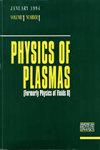Electron tail suppression and effective collisionality due to synchrotron emission and absorption in mildly relativistic plasmas
IF 2.2
3区 物理与天体物理
Q3 PHYSICS, FLUIDS & PLASMAS
引用次数: 0
Abstract
Synchrotron radiation losses are a significant cause of concern for high-temperature aneutronic fusion reactions such as proton–Boron 11. The fact that radiation losses occur primarily in the high-energy tail, where the radiation itself has a substantial impact on the electron distribution, necessitates a self-consistent approach to modeling the diffusion and drag induced by synchrotron absorption and emission. Furthermore, an accurate model must account for the fact that the radiation emission spectrum is momentum-dependent, and the plasma opacity is frequency-dependent. Here, we present a simple Fokker–Planck operator, built on a newly solved-for blackbody synchrotron diffusion operator, which captures all relevant features of the synchrotron radiation. Focusing on magnetic mirror fusion plasmas, we show that significant suppression of the electron distribution occurs for relativistic values of the perpendicular electron momentum, which therefore emit much less radiation than predicted under the assumption of a Maxwell–Jüttner distribution.轻度相对论等离子体中同步辐射和吸收导致的电子尾抑制和有效碰撞性
同步辐射损失是质子-硼 11 等高温非中子聚变反应的一个重要关注点。事实上,辐射损失主要发生在高能尾部,辐射本身对电子分布有很大影响,因此需要一种自洽的方法来模拟同步辐射吸收和发射引起的扩散和阻力。此外,精确的模型必须考虑到辐射发射光谱与动量有关,而等离子体的不透明性与频率有关。在这里,我们提出了一个简单的福克-普朗克算子,它建立在一个新求解的黑体同步辐射扩散算子之上,能够捕捉到同步辐射的所有相关特征。我们重点研究了磁镜聚变等离子体,结果表明垂直电子动量的相对论值会显著抑制电子分布,因此其辐射量远远小于根据麦克斯韦-居特纳分布假设预测的辐射量。
本文章由计算机程序翻译,如有差异,请以英文原文为准。
求助全文
约1分钟内获得全文
求助全文
来源期刊

Physics of Plasmas
物理-物理:流体与等离子体
CiteScore
4.10
自引率
22.70%
发文量
653
审稿时长
2.5 months
期刊介绍:
Physics of Plasmas (PoP), published by AIP Publishing in cooperation with the APS Division of Plasma Physics, is committed to the publication of original research in all areas of experimental and theoretical plasma physics. PoP publishes comprehensive and in-depth review manuscripts covering important areas of study and Special Topics highlighting new and cutting-edge developments in plasma physics. Every year a special issue publishes the invited and review papers from the most recent meeting of the APS Division of Plasma Physics. PoP covers a broad range of important research in this dynamic field, including:
-Basic plasma phenomena, waves, instabilities
-Nonlinear phenomena, turbulence, transport
-Magnetically confined plasmas, heating, confinement
-Inertially confined plasmas, high-energy density plasma science, warm dense matter
-Ionospheric, solar-system, and astrophysical plasmas
-Lasers, particle beams, accelerators, radiation generation
-Radiation emission, absorption, and transport
-Low-temperature plasmas, plasma applications, plasma sources, sheaths
-Dusty plasmas
 求助内容:
求助内容: 应助结果提醒方式:
应助结果提醒方式:


